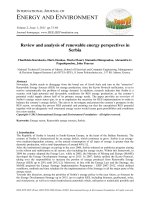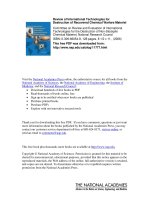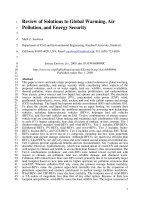Kaplan MCAT review 2015 biochemistry review
Bạn đang xem bản rút gọn của tài liệu. Xem và tải ngay bản đầy đủ của tài liệu tại đây (24.91 MB, 845 trang )
MCAT® Biochemistry Review
Edited by Alexander Stone Macnow, MD
Table of Contents
1. MCAT® Biochemistry Review
1. Cover
1. Title Page
2. Table of Contents
3. The Kaplan MCAT Review Team
4. About Scientific American
5. About the MCAT
6. How This Book Was Created
7. Using This Book
2. Chapter 1: Amino Acids, Peptides, and Proteins
1. Amino Acids, Peptides, and Proteins
2. Introduction
3. 1.1 Amino Acids Found in Proteins
4. 1.2 Acid–Base Chemistry of Amino Acids
5. 1.3 Peptide Bond Formation and Hydrolysis
6. 1.4 Primary and Secondary Protein Structure
7. 1.5 Tertiary and Quaternary Protein Structure
8. 1.6 Denaturation
9. Conclusion
10. Concept Summary
11. Answers to Concept Checks
12. Equations to Remember
13. Shared Concepts
14. Practice Questions
15. Answers and Explanations
3. Chapter 2: Enzymes
1. Enzymes
2. Introduction
3. 2.1 Enzymes as Biological Catalysts
4. 2.2 Mechanisms of Enzyme Activity
5. 2.3 Enzyme Kinetics
6. 2.4 Effects of Local Conditions on Enzyme Activity
7. 2.5 Regulation of Enzyme Activity
8. Conclusion
9. Concept Summary
10. Answers to Concept Checks
11. Equations to Remember
12. Shared Concepts
13. Practice Questions
14. Answers and Explanations
4. Chapter 3: Nonenzymatic Protein Function and Protein Analysis
1. Nonenzymatic Protein Function and Protein Analysis
2. Introduction
3. 3.1 Cellular Functions
4. 3.2 Biosignaling
5. 3.3 Protein Isolation
6. 3.4 Protein Analysis
7. Conclusion
8. Concept Summary
9. Answers to Concept Checks
10. Equations to Remember
11. Shared Concepts
12. Practice Questions
13. Answers and Explanations
5. Chapter 4: Carbohydrate Structure and Function
1. Carbohydrate Structure and Function
2. Introduction
3. 4.1 Carbohydrate Classification
4. 4.2 Cyclic Sugar Molecules
5. 4.3 Monosaccharides
6. 4.4 Complex Carbohydrates
7. Conclusion
8. Concept Summary
9. Answers to Concept Checks
10. Equations to Remember
11. Shared Concepts
12. Practice Questions
13. Answers and Explanations
6. Chapter 5: Lipid Structure and Function
1. Lipid Structure and Function
2. Introduction
3. 5.1 Structural Lipids
4. 5.2 Signaling Lipids
5. 5.3 Energy Storage
6. Conclusion
7. Concept Summary
8. Answers to Concept Checks
9. Shared Concepts
10. Practice Questions
11. Answers and Explanations
7. Chapter 6: DNA and Biotechnology
1. DNA and Biotechnology
2. Introduction
3. 6.1 DNA Structure
4. 6.2 Eukaryotic Chromosome Organization
5. 6.3 DNA Replication
6. 6.4 DNA Repair
7. 6.5 Recombinant DNA and Biotechnology
8. Conclusion
9. Concept Summary
10. Answers to Concept Checks
11. Shared Concepts
12. Practice Questions
13. Answers and Explanations
8. Chapter 7: RNA and the Genetic Code
1. RNA and the Genetic Code
2. Introduction
3. 7.1 The Genetic Code
4. 7.2 Transcription
5. 7.3 Translation
6. 7.4 Control of Gene expression in Prokaryotes
7. 7.5 Control of Gene Expression in Eukaryotes
8. Conclusion
9. Concept Summary
10. Answers to Concept Checks
11. Shared Concepts
12. Practice Questions
13. Answers and Explanations
9. Chapter 8: Biological Membranes
1. Biological Membranes
2. Introduction
3. 8.1 Fluid Mosaic Model
4. 8.2 Membrane Components
5. 8.3 Membrane Transport
6. 8.4 Specialized Membranes
7. Conclusion
8. Concept Summary
9. Answers to Concept Checks
10. Equations to Remember
11. Shared Concepts
12. Practice Questions
13. Answers and Explanations
10. Chapter 9: Carbohydrate Metabolism I: Glycolysis, Glycogen, Gluconeogenesis, and the
Pentose Phosphate Pathway
1. Carbohydrate Metabolism I: Glycolysis, Glycogen, Gluconeogenesis, and the Pentose
Phosphate Pathway
2. Introduction
3. 9.1 Glucose Transport
4. 9.2 Glycolysis
5. 9.3 Other Monosaccharides
6. 9.4 Pyruvate Dehydrogenase
7. 9.5 Glycogenesis and Glycogenolysis
8. 9.6 Gluconeogenesis
9. 9.7 The Pentose Phosphate Pathway
10. Conclusion
11. Concept Summary
12. Answers to Concept Checks
13. Shared Concepts
14. Practice Questions
15. Answers and Explanations
11. Chapter 10: Carbohydrate Metabolism II: Aerobic Respiration
1. Carbohydrate Metabolism II: Aerobic Respiration
2. Introduction
3. 10.1 Acetyl-CoA
4. 10.2 Reactions of the Citric Acid Cycle
5. 10.3 The Electron Transport Chain
6. 10.4 Oxidative Phosphorylation
7. Conclusion
8. Concept Summary
9. Answers to Concept Checks
10. Shared Concepts
11. Practice Questions
12. Answers and Explanations
12. Chapter 11: Lipid and Amino Acid Metabolism
1. Lipid and Amino Acid Metabolism
2. Introduction
3. 11.1 Lipid Digestion and Absorption
4. 11.2 Lipid Mobilization
5. 11.3 Lipid Transport
6. 11.4 Cholesterol Metabolism
7. 11.5 Fatty Acids and Triacylglycerols
8. 11.6 Ketone Bodies
9. 11.7 Protein Catabolism
10. Conclusion
11. Concept Summary
12. Answers to Concept Checks
13. Shared Concepts
14. Practice Questions
15. Answers and Explanations
13. Chapter 12: Bioenergetics and Regulation of Metabolism
1. Bioenergetics and Regulation of Metabolism
2. Introduction
3. 12.1 Thermodynamics and Bioenergetics
4. 12.2 The Role of ATP
5. 12.3 Biological Oxidation and Reduction
6. 12.4 Metabolic States
7. 12.5 Hormonal Regulation of Metabolism
8. 12.6 Tissue-Specific Metabolism
9. 12.7 Integrative Metabolism
10. Conclusion
11. Concept Summary
12. Answers to Concept Checks
13. Equations to Remember
14. Shared Concepts
15. Practice Questions
16. Answers and Explanations
14. About This Book
1. Copyright Information
2. Glossary
3. Index
4. Art Credits
5. Special Offer for Kaplan Students
The Kaplan MCAT Review Team
Alexander Stone Macnow, MD
Editor-in-Chief
Tyra Hall-Pogar, PhD
Editor
Bela G. Starkman, PhD
Editor
Joshua D. Brooks, PhD
Kaplan MCAT Faculty
Alisha Maureen Crowley
Kaplan MCAT Faculty
Samer T. Ismail
Kaplan MCAT Faculty
Kelly Kyker-Snowman, MS
Kaplan MCAT Faculty
Christopher Lopez
Kaplan MCAT Faculty
MCAT faculty reviewers Elmar R. Aliyev; James Burns; Jonathan Cornfield; Nikolai Dorofeev, MD;
Benjamin Downer, MS; Colin Doyle; M. Dominic Eggert; Marilyn Engle; Eleni M. Eren; Raef Ali
Fadel; Scott Huff; Elizabeth A. Kudlaty; Ningfei Li; John P. Mahon; Matthew A. Meier; Nainika
Nanda; Caroline Nkemdilim Opene; Kaitlyn E. Prenger; Uneeb Qureshi; Derek Rusnak, MA; Kristen
L. Russell, ME; Michael Paul Tomani, MS; Nicholas M. White; Kerranna Williamson, MBA; Allison
Ann Wilkes, MS; and Tony Yu
Thanks to Kim Bowers; Tim Eich; Samantha Fallon; Owen Farcy; Dan Frey; Robin Garmise; Rita
Garthaffner; Joanna Graham; Adam Grey; Allison Harm; Beth Hoffberg; Aaron Lemon-Strauss; Keith
Lubeley; Diane McGarvey; Petros Minasi; John Polstein; Deeangelee Pooran-Kublall, MD, MPH;
Rochelle Rothstein, MD; Larry Rudman; Sylvia Tidwell Scheuring; Carly Schnur; Karin Tucker; Lee
Weiss; and the countless others who made this project possible.
About Scientific American
Scientific American is at the heart of Nature Publishing Group’s consumer media division, meeting
the needs of the general public. Founded in 1845, Scientific American is the longest continuously
published magazine in the United States and the leading authoritative publication for science in the
general media. In its history, 148 Nobel Prize scientists have contributed 240 articles to Scientific
American, including Albert Einstein, Francis Crick, Stanley Prusiner, and Richard Axel.
Together with scientificamerican.com and in translation in 14 languages around the world, it
reaches more than 5 million consumers and scientists. Other titles include Scientific American Mind
and Spektrum der Wissenschaft in Germany. Scientific American won a 2011 National Magazine
Award for General Excellence.
About the MCAT
The structure of the four sections of the MCAT is shown below.
Chemical and Physical Foundations of Biological Systems
Time
Format
95 minutes
59 questions
Score between 118 and 132
Most questions are passage-based, but some are discrete (stand-alone) questions
What It Tests
Biochemistry: 25%
Biology: 5%
General Chemistry: 30%
Organic Chemistry: 15%
Physics: 25%
Critical Analysis and Reasoning Skills (CARS)
Time
Format
90 minutes
53 questions
Score between 118 and 132
All questions are passage-based. There are no discrete (stand-alone) questions.
What It Tests
Disciplines:
Humanities: 50%
Social Sciences: 50%
Skills:
Foundations of Comprehension: 30%
Reasoning Within the Text: 30%
Reasoning Beyond the Text: 40%
Biological and Biochemical Foundations of Living Systems
Time
Format
95 minutes
59 questions
Score between 118 and 132
Most questions are passage-based, but some are discrete (stand-alone) questions
What It Tests
Biochemistry: 25%
Biology: 65%
General Chemistry: 5%
Organic Chemistry: 5%
Psychological, Social, and Biological Foundations of Behavior
Time
95 minutes
59 questions
Format
Score between 118 and 132
Most questions are passage-based, but some are discrete (stand-alone) questions
Biology: 5%
What It Tests
Psychology: 65%
Sociology: 30%
Total
Testing Time
375 minutes (6 hours, 15 minutes)
Questions
230
Score
472 to 528
The MCAT also tests four Scientific Inquiry and Reasoning Skills (SIRS):
1. Knowledge of Scientific Concepts and Principles (35% of questions)
2. Scientific Reasoning and Problem-Solving (45% of questions)
3. Reasoning About the Design and Execution of Research (10% of questions)
4. Data-Based and Statistical Reasoning (10% of questions)
The MCAT is a computer-based test (CBT) and is offered at Prometric centers during almost every
month of the year. There are optional breaks between each section, and there is a lunch break between
the second and third section of the exam.
Register online for the MCAT at www.aamc.org/mcat
.
For further questions, contact the MCAT team at the Association of American Medical Colleges:
MCAT Resource Center
Association of American Medical Colleges
(202) 828-0690
www.aamc.org/mcat
How This Book Was Created
The Kaplan MCAT Review project began in November 2012 shortly after the release of the Preview
Guide for the MCAT 2015 Exam, 2nd edition. Through thorough analysis by our staff
psychometricians, we were able to analyze the relative yield of the different topics on the MCAT, and
we began constructing tables of contents for the books of the Kaplan MCAT Review series.
Writing of the books began in April 2013. A dedicated staff of 19 writers, 7 editors, and 32
proofreaders worked over 5000 combined hours to produce these books. The format of the books was
heavily influenced by weekly meetings with Kaplan’s learning-science team.
These books were submitted for publication in late March and early April 2014. For any updates
after this date, please visit www.kaplanmcat.com .
The information presented in these books covers everything listed on the official MCAT content lists
—nothing more, nothing less. Every topic in these lists is covered in the same level of detail as is
common to the undergraduate and postbaccalaureate classes that are considered prerequisites for the
MCAT. Note that your premedical classes may cover topics not discussed in these books, or they may
go into more depth than these books do. Additional exposure to science content is never a bad thing,
but recognize that all of the content knowledge you are expected to have walking in on Test Day is
covered in these books.
If you have any questions about the content presented here, email
. For other questions not related to content, email
.
Each book has been vetted through at least six rounds of review. To that end, the information
presented is these books is true and accurate to the best of our knowledge. Still, your feedback helps
us improve our prep materials. Please notify us of any inaccuracies or errors in the books by sending
an email to .
Using This Book
Kaplan MCAT Biochemistry Review, along with the other six books in the Kaplan MCAT Review
series, brings the Kaplan classroom experience to you—right in your home, at your convenience. This
book offers the same Kaplan content review, strategies, and practice that make Kaplan the #1 choice
for MCAT prep. After all, twice as many doctors prepared with Kaplan for the MCAT than with any
other course.
This book is designed to help you review the biochemistry topics covered on the MCAT. It represents
one of the content review resources available to you. Additional review is available in your Online
Center, including more practice questions, video science review, and full-length practice exams.
Register for your Online Center at kaptest.com/booksonline .
Please understand that content review—no matter how thorough—is not sufficient preparation for the
MCAT! The MCAT tests not only your science knowledge but also your critical reading, reasoning,
and problem-solving skills. Do not assume that simply memorizing the contents of this book will earn
you high scores on Test Day; to maximize your scores, you must also improve your reading and testtaking skills through MCAT-style questions and practice tests.
MCAT CONCEPT CHECKS
At the end of each section, you’ll find a few open-ended questions that you can use to assess your
mastery of the material. These MCAT Concept Checks were introduced after multiple conversations
with Kaplan’s learning-science team. Research has demonstrated repeatedly that introspection and
self-analysis improve mastery, retention, and recall of material. Complete these MCAT Concept
Checks to ensure that you’ve got the key points from each section before moving on!
PRACTICE QUESTIONS
At the end of each chapter, you’ll find 15 MCAT-style practice questions. These are designed to help
you assess your understanding of the chapter you just read. Most of these questions focus on the first
of the Scientific Inquiry and Reasoning Skills (Knowledge of Scientific Concepts and Principles),
although there are occasional questions that fall into the second or fourth SIRS (Scientific Reasoning
and Problem-Solving, and Data-Based and Statistical Reasoning, respectively).
SIDEBARS
The following is a guide to the five types of sidebars you’ll find in Kaplan MCAT Biochemistry
Review:
Bridge: These sidebars create connections between science topics that appear in multiple
chapters throughout the Kaplan MCAT Review series.
Key Concept: These sidebars draw attention to the most important takeaways in a given topic,
and they sometimes offer synopses or overviews of complex information. If you understand
nothing else, make sure you grasp the Key Concepts for any given subject.
MCAT Expertise: These sidebars point out how information may be tested on the MCAT or
offer key strategy points and test-taking tips that you should apply on Test Day.
Mnemonic: These sidebars present memory devices to help recall certain facts.
Real World: These sidebars illustrate how a concept in the text relates to the practice of
medicine or the world at large. While this is not information you need to know for Test Day,
many of the topics in Real World sidebars are excellent examples of how a concept may appear
in a passage or discrete (stand-alone) question on the MCAT.
This book also contains a thorough glossary and index for easy navigation of the text.
In this end, this is your book, so write in the margins, draw diagrams, highlight the key points—do
whatever is necessary to help you get that higher score. We look forward to working with you as you
achieve your dreams and become the doctor you deserve to be!
In This Chapter
1.1
1.2
1.3
1.4
1.5
1.6
Amino Acids Found in Proteins
A Note on Terminology
Stereochemistry of Amino Acids
Structures of the Amino Acids
Hydrophobic and Hydrophilic Amino Acids
Acid–Base Chemistry of Amino Acids
Protonation and Deprotonation
Titration of Amino Acids
Peptide Bond Formation and Hydrolysis
Peptide Bond Formation
Peptide Bond Hydrolysis
Primary and Secondary Protein Structure
Primary Structure
Secondary Structure
Tertiary and Quaternary Protein Structure
Tertiary Structure
Folding and the Solvation Layer
Quaternary Structure
Conjugated Proteins
Denaturation
Concept Summary
Introduction
How important are amino acids? Consider sickle cell disease. People with sickle cell disease have
red blood cells that, under certain conditions, can become rigid and sickle-shaped. Those sickleshaped cells can become stuck in capillaries, blocking them. In severe cases, it can block enough of
the blood supply to cause damage to several organs, such as the kidneys, liver, and spleen. This
happens because of a mutation in hemoglobin, the protein in red blood cells that transports oxygen.
Remarkably, the difference between the normal form of hemoglobin, HbA, and the one that causes
sickle cell disease, HbS, is a seemingly minor one. All it takes is a change in a single amino acid on
the surface of hemoglobin: the sixth amino acid in two of its four chains is changed from glutamic
acid to valine. That minor difference allows the deoxygenated form of HbS to polymerize and
precipitate, which leads to the sickled shape—and all the symptoms of—sickle cell disease.
In this chapter, we’ll take a look at the basics of proteins by focusing on the amino acids that compose
them, and how those amino acids contribute to the physical and chemical properties of proteins.
1.1 Amino Acids Found in Proteins
Amino acids are molecules that contain two functional groups: an amino group (–NH2) and a
carboxyl group (–COOH). In this chapter, we’ll focus specifically on the α-amino acids, in which the
amino group and the carboxyl group are bonded to the same carbon, the α-carbon of the carboxylic
acid. Think of the α-carbon as the central carbon of the amino acid, as shown in Figure 1.1.
Figure 1.1. Amino Acid Structure
BRIDGE
As you saw in Chapter 8 of MCAT Organic Chemistry Review, remember that for carboxylic
acids, the α-carbon is the carbon adjacent to the carboxyl carbon.
In addition to the amino and carboxyl groups, the α-carbon has two other groups attached to it: a
hydrogen atom, and a side chain, also called an R group, which is specific to each amino acid. The
side chains determine the properties of amino acids, and therefore their functions.
KEY CONCEPT
The side chains (R groups) of amino acids determine their chemical properties.
A NOTE ON TERMINOLOGY
Amino acids don’t need to have both the amino and carboxyl groups bonded to the same carbon. For
example, the neurotransmitter γ-aminobutyric acid (GABA) has the amino group on the gamma (γ)
carbon, three carbons away from the carboxyl group. Similarly, not every amino acid found in the
human body is specified by a codon in the genetic code or incorporated into proteins. One example is
ornithine, one of the intermediates in the urea cycle, the metabolic process by which the body
excretes excess nitrogen. There are also some amino acids that are specifically modified for
specialized roles in the body; for example, lysine is sometimes converted into pyrrolysine, and
cysteine is sometimes converted into selenocysteine.
That said, the Association of American Medical Colleges (AAMC) has specifically stated they’ll
focus on the 20 α-amino acids encoded by the human genetic code, also called proteinogenic amino
acids. So, for the rest of this chapter, we’ll use the term amino acid to refer specifically to these
compounds.
MCAT EXPERTISE
While the MCAT could include passages on GABA or other nonstandard amino acids, they
are not part of the background information you’re expected to know for Test Day.









